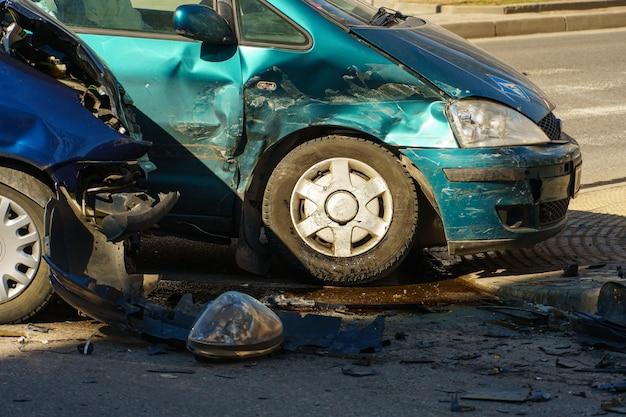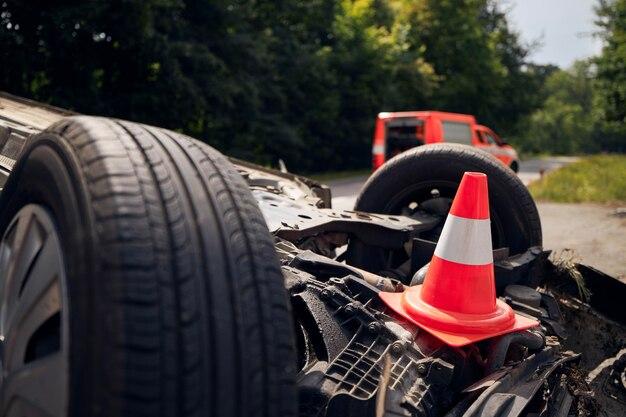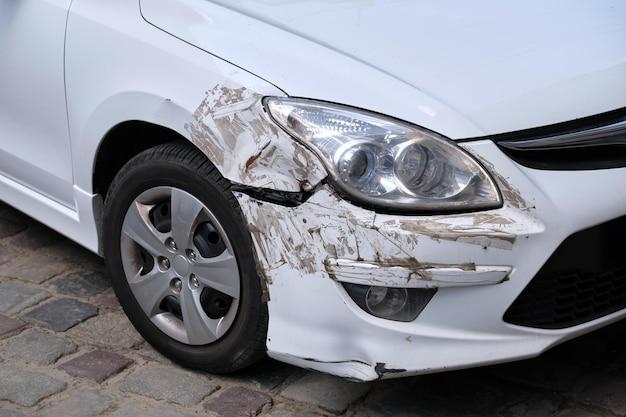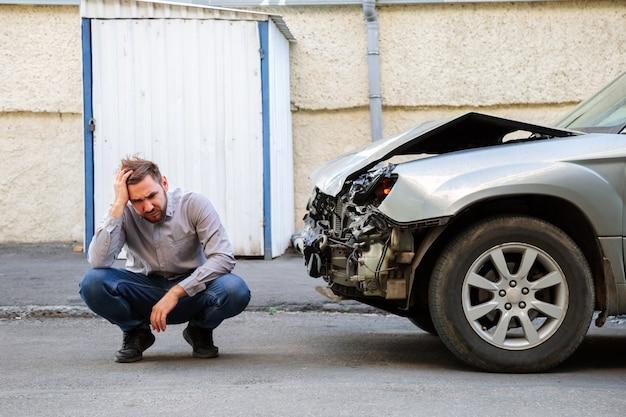Introduction
Car accidents can lead to severe injuries, and spinal cord injuries are among the worst. Spinal injuries from car accidents can have long-lasting and devastating effects on an individual’s health and quality of life. Most spinal injuries occur due to the sudden impact of the accident, causing damage to the spine and spinal cord.
It’s crucial to identify the signs of a spinal cord injury after a car accident, as early identification can often lead to better treatment outcomes. However, not all spinal injuries are visible, and many people don’t experience any immediate symptoms. This is why it’s essential to understand the common types of spinal injuries that can occur and the symptoms they cause.
In this blog post, we’ll discuss the types of spinal injuries that are common in car accidents, the signs and symptoms of a spinal cord injury, and what happens to your spine after a car accident. We’ll also provide information on what you can expect during your recovery and how to receive compensation for your spinal injury.
So, if you or someone you know has been in a car accident, keep reading to learn more about spinal injuries and why they should never be ignored.
Understanding Spinal Injuries from Car Accidents
Car accidents can be catastrophic and traumatic, and they often result in various spinal injuries. These injuries can range from mild to severe, and they can significantly impact a victim’s physical and emotional well-being.
Types of Spinal Injuries
Spinal injuries are generally classified into two categories: complete and incomplete injuries. Complete injuries involve a total loss of mobility and feeling below the injury level, while incomplete injuries involve partial loss of mobility or sensation. Some common spinal injuries resulting from car accidents include:
Spinal Fractures
Spinal fractures can occur when the vertebral bones in the spine are compressed or disrupted due to the force of an accident. In severe cases, spinal fractures can lead to permanent loss of mobility and sensation.
Herniated Disc
Herniated discs are a painful injury that occurs when the soft cushioning disc between the vertebrae ruptures or tears. This injury can cause numbness, tingling, and weakness in the affected area.
Spinal Cord Injury
The spinal cord is a crucial component of the body’s nervous system, and injuries to this area can have devastating consequences. Spinal cord injuries can cause permanent paralysis, loss of sensation, and difficulty breathing.
Seeking Treatment
If you’ve been involved in a car accident and suspect you’ve suffered a spinal injury, it’s essential to seek prompt medical attention. Early diagnosis and treatment can help prevent long-term complications and improve your chances of a full recovery. Treatment options for spinal injuries may include surgery, physical therapy, and medication.
Spinal injuries resulting from car accidents can be life-altering and have a significant impact on a victim’s quality of life. However, with early diagnosis and proper treatment, many patients can make a full recovery and regain mobility and function. If you’re involved in a car accident and believe you’ve suffered a spinal injury, seek medical attention immediately and follow your doctor’s instructions for treatment and rehabilitation.
Types of Spinal Injuries from Car Accidents
Car accidents are one of the leading causes of spinal injuries. Unfortunately, these types of injuries can have severe and long-term effects on an individual’s overall health and well-being. In this section, we will discuss the various types of spinal injuries that can occur due to a car accident.
1. Herniated Discs
A herniated disc occurs when the soft, jelly-like material inside a spinal disc pushes through a tear or rupture in the disc’s outer layer. This type of injury can cause pain, numbness, and weakness in the affected area.
2. Compression Fractures
A compression fracture occurs when a vertebra in the spine collapses or becomes compressed. This type of injury can result in severe pain, deformity of the spine, and loss of mobility.
3. Spinal Cord Injuries
Spinal cord injuries are among the most serious types of injuries that can occur in a car accident. These injuries can result in partial or complete paralysis, loss of sensation, and difficulty breathing or controlling bodily functions.
4. Whiplash
Whiplash is a common type of spinal injury that occurs when the neck is forcefully jolted forward and then backward, causing the neck to hyperextend and then hyperflex. This type of injury can cause neck pain, stiffness, headaches, and even cognitive and psychological symptoms.
In conclusion, spinal injuries from car accidents can have serious and long-lasting effects on an individual’s health and quality of life. It’s important to seek medical attention as soon as possible if you’ve been involved in an accident. Understanding the different types of spinal injuries can also help you recognize symptoms and seek appropriate treatment.
Primary Spinal Cord Injury
Spinal cord injuries caused by car accidents are classified into two categories: primary spinal cord injury and secondary spinal cord injury. Primary spinal cord injury refers to damage suffered by the spinal cord at the time of the accident, while secondary spinal cord injury refers to damage that occurs in the hours or days following the accident.
Understanding Primary Spinal Cord Injury
Primary spinal cord injury occurs when the spinal cord is damaged due to an impact during a car accident. It can also result from severe compression or stretching of the spinal cord during an accident. The injury can range from mild to severe and can result in tetraplegia (paralysis of all four limbs) or paraplegia (paralysis of the lower half of the body).
Signs and Symptoms of Primary Spinal Cord Injury
The signs and symptoms of primary spinal cord injury may include loss of sensation, loss of motor function, loss of bowel and bladder function, and difficulty breathing. Other symptoms may include muscle spasms, numbness, tingling, and difficulty with balance and coordination.
Treatment Options for Primary Spinal Cord Injury
There is currently no cure for primary spinal cord injury. However, immediate treatment is critical to prevent further damage and improve the chances of recovery. Treatment options may include immobilization of the spine, medication for pain and inflammation, respiratory support, and surgery to decompress the spinal cord.
Prevention of Primary Spinal Cord Injury
Preventing primary spinal cord injury in car accidents involves adhering to basic safety measures, such as wearing seat belts, obeying traffic laws, avoiding distracted driving, and driving while sober. It is also essential to seek immediate medical attention if you are involved in a car accident to ensure early diagnosis and treatment.
In conclusion, primary spinal cord injury resulting from car accidents can be devastating, but understanding the signs and symptoms can help you seek prompt medical attention. Adhering to basic safety measures and seeking immediate medical attention can go a long way in preventing primary spinal cord injury.
Broken Back from a Car Accident
A spinal injury is a severe consequence of car accidents, and one of the most devastating forms of spinal injury is a broken back. This type of injury can cause permanent disabilities and even paralysis if not treated urgently, making it crucial to seek medical assistance immediately after a car accident.
Causes of Broken Back in Car Accidents
A broken back happens when one or more vertebrae in the spine break or crack. The force exerted during a car accident can cause such injuries, especially in high-speed collisions.
Symptoms of a Broken Back
It is not always easy to identify a broken back since some symptoms may not be evident immediately after the accident. Common symptoms of a broken back include severe back pain, muscle spasms, numbness, or tingling in the legs, and difficulty walking.
Treatment of a Broken Back
A broken back requires immediate medical attention to prevent further complications. Depending on the severity of the injury, treatments can range from wearing a back brace to surgery to fuse the spine.
Rehabilitation and Recovery from a Broken Back
Rehabilitation and recovery from a broken back can take time, and working with a physiotherapist is crucial. Therapies may include specialized exercises, massages, and occupational therapy. The length of recovery and rehabilitation for a broken back depends on the severity of the injury.
Preventing Broken Backs in Car Accidents
Preventing a broken back in a car accident involves taking steps to ensure safety while driving, such as avoiding distractions and wearing a seatbelt. It is also important to practice defensive driving, maintain a safe distance from other cars, and comply with traffic rules.
In conclusion, a broken back is one of the most severe forms of spinal injury from car accidents and requires urgent medical attention. Knowing the causes, symptoms, treatment, recovery, and prevention of broken backs can help minimize the risk of severe injuries or paralysis from car accidents.
Spinal Injury Car Accident Settlement
If you’ve been injured in a car accident, you may be wondering how to get compensated for your pain and suffering. Spinal injuries are particularly serious and can result in significant long-term effects. Here are a few things to keep in mind when seeking a spinal injury car accident settlement.
Seek Medical Attention
The first step in any personal injury case is to seek medical attention. This is especially important if you have sustained a spinal injury. Spinal injuries can cause long-term damage if left untreated, and it’s essential to get proper medical care as soon as possible.
Get Legal Representation
Once you’ve sought medical attention, the next step is to seek legal representation. A spinal injury car accident settlement can be complicated and challenging to navigate on your own. A personal injury lawyer can help you understand your rights and the compensation you may be entitled to.
Understand the Settlement Process
The settlement process can be complex, and it’s essential to understand the steps involved. Your lawyer will be able to provide you with an overview, but it’s important to know what to expect. This can help you make informed decisions about your case and ensure that you’re getting the compensation you deserve.
Consider Your Long-Term Needs
Spinal injuries can result in long-term physical and emotional effects. When seeking a settlement, it’s essential to consider your long-term needs. This may include ongoing medical treatment, rehabilitation, or other support services. Your lawyer can help you factor in these needs when negotiating a settlement.
Don’t Take the First Offer
When negotiating a settlement, it’s essential not to take the first offer. Insurance companies may try to offer you a lower settlement than you deserve. Your lawyer can help you understand your rights and negotiate a fair settlement that covers your expenses and compensation for your pain and suffering.
In conclusion, seeking a spinal injury car accident settlement can be a complex and challenging process. However, with the right legal representation, you can get the compensation you deserve and focus on your long-term recovery.
Cervical Spine Injury from Car Accident
Car accidents can be detrimental to the body, and among the most severe injuries that can be sustained is a cervical spine injury. The cervical spine, also known as the neck, serves as a bridge between the skull and the rest of the body, comprising seven vertebrae, including discs and joints. Any damage to the cervical spine can cause severe complications, including paralysis or death.
Symptoms
After an accident, individuals may experience immediate or delayed symptoms of cervical spine injury. These symptoms may include neck pain, stiffness, or tenderness. They may also include difficulty in moving the neck, headache, dizziness, and numbness of the hands or legs. If you or someone you know shows any of these symptoms after an accident, seek medical attention immediately.
Diagnosis
After a car accident, make sure to see a doctor for a thorough examination. The doctor will perform a physical examination and may request x-rays, MRI scans, or CT scans to determine if there has been any damage to the cervical spine. Early diagnosis is essential as symptoms may not appear until hours or even days after the accident.
Treatment
Treatment for cervical spine injuries varies depending on the severity of the injury. For minor injuries, physicians may recommend rest, hot and cold therapy, and pain medication. For other more severe injuries such as fractures or dislocations, surgery may be necessary. Physiotherapy or chiropractic treatment may also be recommended for rehabilitation and pain management.
Prevention
Wearing a seatbelt is important for preventing cervical spine injuries. Research shows that seatbelts significantly reduce the risk of injury and death in car accidents. Additionally, headrests and airbags in automobiles can help to reduce the severity of injury in the event of an accident.
Cervical spine injuries can be mild or severe, and any damage sustained to this area must be taken seriously. Immediate medical attention is required if you or someone you know shows any symptoms of a cervical spine injury. Remember to use preventative measures such as seatbelts, headrests, and airbags to reduce the risk of injury in the event of a car crash.
What are the 5 signs of a Spinal Injury
When it comes to spinal injuries, it is important to catch them early and seek medical treatment as soon as possible. Here are five key signs of a spinal injury to look out for:
1. Pain or Pressure in the Neck or Back
Pain or pressure in the neck or back is often the first sign of a spinal injury. You may feel a sudden onset of pain in your neck or back after a car accident. You might also feel pressure or a shooting pain in your spine. Seek immediate medical attention if you experience this symptom.
2. Loss of Movement
If you experience any loss of movement or weakness in your arms or legs after a car accident, it could indicate a spinal injury. This could include difficulty standing, walking, or moving your extremities. If you experience this symptom, seek medical attention right away.
3. Numbness or Tingling in the Extremities
Numbness or tingling in your arms or legs is another sign of a spinal injury. This could include a loss of sensation in your arms, legs, hands, or feet. If you experience this symptom after a car accident, seek medical attention immediately.
4. Difficulty Breathing
Difficulty breathing can be a sign of a serious spinal injury. This may be because your spine is directly connected to your respiratory system. Seek medical attention right away if you experience any difficulty breathing or shortness of breath after a car accident.
5. Loss of Bladder or Bowel Control
Loss of bladder or bowel control is a serious sign of a spinal injury. While this is a less common symptom, it is very important to seek medical attention immediately if you experience this, as it could indicate a severe spinal injury.
Remember, if you experience any of these symptoms after a car accident, it is essential to seek medical attention right away. Early treatment can make all the difference when it comes to a spinal injury.
What Happens to Your Spine After a Car Accident
Car accidents can cause a range of injuries, from minor cuts and bruises to serious spinal injuries. When it comes to spinal injuries, they can happen even in low-speed collisions. These injuries can be severe and have long-term effects. So what exactly happens to your spine after a car accident? Let’s dive in.
Whiplash
One of the most common spinal injuries that occur in car accidents is whiplash. Whiplash is a neck injury caused by a sudden jerking motion of the head, forwards and backward, or sideways. It can cause damage to the muscles and ligaments in the neck and upper back. Symptoms of whiplash may include neck pain, stiffness, headaches, and dizziness. It’s essential to seek medical attention for whiplash injuries to prevent chronic pain.
Herniated Discs
A herniated disc occurs when the soft tissue inside the spinal disc protrudes through its outer layer. It can occur due to the impact of the car crash. It often causes pain, numbness, and weakness in the arms or legs, depending on where the herniated disc is located.
Spinal Fractures
High-speed collisions or accidents involving larger vehicles can cause spinal fractures. The impact can cause your spine to compress and make it unstable. Symptoms of spinal fractures may include severe pain, numbness, or paralysis and could require surgery.
Spinal Cord Injuries
Spinal cord injuries are the most severe spinal injuries that can occur in a car accident. Spinal cord injuries happen when there is a traumatic blow to the spine that can result in partial or complete paralysis. It can have a life-altering impact on the victim and their family.
Seeking Treatment
Even if you feel fine after a car accident, it’s essential to seek medical attention. Some spinal injuries may not show up for days or weeks after the accident. Delaying treatment could worsen the injury and even lead to permanent damage.
In conclusion, car accidents can cause various spinal injuries, some of which could have long-term impacts on your life. It’s essential to seek medical attention after an accident to prevent chronic pain or permanent damage. Remember to always drive safely and wear your seatbelt. Stay safe on the road!
Most Common Spinal Injury in a Car Accident
Car accidents can leave victims with various types of injuries, and one of the most severe is a spinal injury. When the spinal cord is damaged, it can have a lasting impact on mobility, sensation, and overall quality of life.
So, what is the most common spinal injury in a car accident? Whiplash is the top choice. This injury occurs when the head suddenly jerks forward and then backward, causing the neck’s muscles and ligaments to overextend and tear. Whiplash often occurs in rear-end collisions when the car stops suddenly, and the force of the impact causes the head to jolt violently.
While some people may experience minor whiplash, others may suffer from chronic pain, limited mobility, and even permanent nerve damage. The symptoms of whiplash include neck pain, stiffness, and headaches; these might not show up immediately but can take several hours or even days to appear.
Another common spinal injury in car accidents is a herniated disc. This occurs when the trauma from the crash causes the gelatinous center of a spinal disc to rupture through its outer layer. The result is a severe pain that usually affects the lower back or neck, depending on where the herniated disc occurred.
Fractured vertebrae are yet another common spinal injury in car accidents. A fracture can occur anywhere along the spine, but it is most likely to happen in the lower back or neck, where the spinal curvature is the most pronounced. A fracture can cause severe pain and discomfort, and in severe cases, it can lead to paralysis.
In conclusion, spinal injuries are some of the most severe injuries that can result from car accidents. While whiplash is the most common spinal injury, herniated discs and fractured vertebrae can also occur. If you’ve been in a car accident and are experiencing symptoms of a spinal injury, seek medical attention immediately.
How do you know if you’ve sustained a spinal cord injury after a car accident
Car accidents can be frightening and stressful, and you might not be aware that you’ve sustained a spinal cord injury until it’s too late. Spinal cord injuries can be severe and potentially life-altering, so it’s important to seek medical attention immediately if you experience any of the following symptoms:
1. Numbness or Tingling
If you experience numbness or tingling in your arms, legs, or fingers, this could be a sign of a spinal cord injury. This occurs when the spinal cord is damaged, and the signals between the brain and body get disrupted.
2. Loss of coordination
Loss of coordination is another sign of a spinal cord injury after a car accident. If you have trouble walking, adapting to changes in terrain, or grasping objects, this could be a sign of a spinal cord injury.
3. Extreme back pain
It’s common to experience back pain after a car accident, but if the pain is severe and persists for an extended period, it could be a sign of a spinal cord injury.
4. Loss of sensation
If you lose sensation in any part of your body after a car accident, this could also be a sign of a spinal cord injury. This is often accompanied by a loss of movement in the affected area.
5. Difficulty breathing
If you have difficulty breathing after a car accident, this could be a sign of a spinal cord injury. The spinal cord plays a significant role in controlling your breathing and other essential bodily functions, so any disruption to its function can result in difficulties breathing.
In conclusion, if you have experienced a car accident and notice any of the above symptoms, it is best to seek immediate medical attention. Spinal cord injuries can be severe and life-altering, but prompt medical intervention can increase your chances of making a full recovery. Remember, your health is your wealth, so don’t take any chances when it comes to your well-being.



